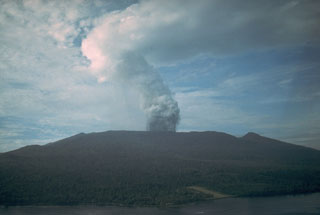Report on Karkar (Papua New Guinea) — September 1979
Scientific Event Alert Network Bulletin, vol. 4, no. 9 (September 1979)
Managing Editor: David Squires.
Karkar (Papua New Guinea) Small explosions through crater lake continue
Please cite this report as:
Global Volcanism Program, 1979. Report on Karkar (Papua New Guinea) (Squires, D., ed.). Scientific Event Alert Network Bulletin, 4:9. Smithsonian Institution. https://doi.org/10.5479/si.GVP.SEAN197909-251030
Karkar
Papua New Guinea
4.647°S, 145.976°E; summit elev. 1839 m
All times are local (unless otherwise noted)
"The relatively low level of activity at the end of August continued until the end of September. Daily observations by helicopter took place until 12 September. The activity continued to consist of small, black, Surtseyan-like bursts breaking through the surface of the small crater lake. Seismic activity continued at a low level, although slight increases in activity appeared as faint bands in the records, a characteristic of this eruption. Several discrete A-type events occurred. Tilt and gravity observations until 12 September showed no significant changes.
"Continuous surveillance using a helicopter will no longer take place unless activity increases again. Instead, a helicopter will be chartered once every 2 weeks to enable detailed visual observations, and tilt and gravity measurements to be made. Seismic monitoring via the permanent surveillance station and two temporary stations will continue as before."
Geological Summary. Karkar is a 19 x 25 km forest-covered island that is truncated by two nested summit calderas. The 5.5 km outer caldera was formed during one or more eruptions, the last of which occurred 9,000 years ago. The steep-walled 300-m-deep, 3.2 km diameter, inner caldera was formed sometime between 1,500 and 800 years ago. Cones are present on the N and S flanks of this basaltic-to-andesitic volcano; a linear array of small cones extends from the northern rim of the outer caldera nearly to the coast. Recorded eruptions date back to 1643 from Bagiai, a pyroclastic cone constructed within the inner caldera, the floor of which is covered by young, mostly unvegetated andesitic lava flows.
Information Contacts: R. Almond, RVO.

